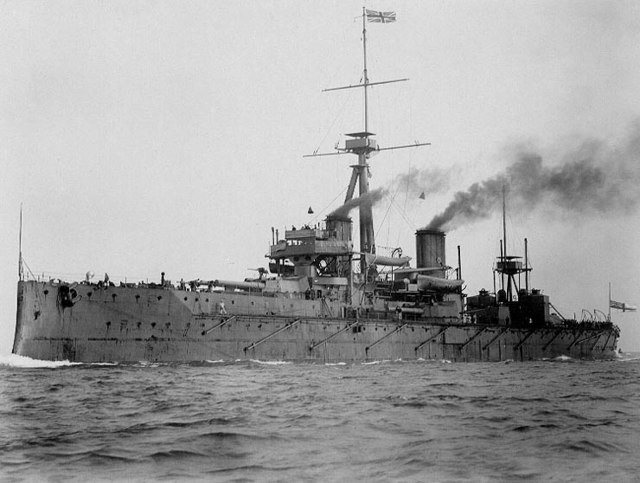Top Qs
Timeline
Chat
Perspective
4th Battle Squadron
Military unit From Wikipedia, the free encyclopedia
Remove ads
The 4th Battle Squadron was a squadron of the British Royal Navy consisting of battleships. The 4th Battle Squadron was initially part of the Royal Navy's Home Fleet (1912–14) and then the Grand Fleet after the outbreak of the First World War. The squadron changed composition often as ships were damaged, retired or transferred.
Remove ads
August 1914

On 5 August 1914, the squadron was constituted as follows:[2]
January 1915
By January 1915, the composition had changed slightly:[2]
- HMS Agincourt
- HMS Bellerophon
- HMS Dreadnought
- HMS Temeraire
- HMS Benbow
- HMS Emperor of India
- HMS Erin
Battle of Jutland, June 1916
As an element in the Grand Fleet, the squadron participated in the Battle of Jutland. During the battle, the composition of the 4th Battle Squadron was as follows:[3]
- Third Division
- HMS Iron Duke, fleet flagship of Admiral Sir John Jellicoe; Captain Frederic Dreyer;
- HMS Royal Oak, Captain Crawford Maclachlan;
- HMS Superb, flagship of Rear Admiral A. L. Duff; Captain E. Hyde-Parker;
- HMS Canada, Captain W. C. M. Nicholson;
- Fourth Division
- HMS Benbow, flagship of Vice Admiral Sir Doveton Sturdee; Captain H. W. Parker;
- HMS Bellerophon, Captain E. F. Bruen;
- HMS Temeraire, Captain E. V. Underhill;
- HMS Vanguard, Captain J. D. Dick;
January 1917
Following the Battle of Jutland, the 4th Battle Squadron was reorganized, with Colossus, Hercules, St. Vincent, Collingwood and Neptune all transferred from the 1st Battle Squadron. In January 1917, the squadron was constituted as follows:[4]
- HMS Bellerophon
- HMS Temeraire
- HMS Vanguard
- HMS Superb
- HMS Colossus
- HMS Hercules
- HMS Neptune
- HMS St. Vincent
- HMS Collingwood
After the loss of HMS Vanguard in July 1917, HMS Superb and HMS Temeraire were detached to the Mediterranean in 1918. HMS Dreadnought rejoined the squadron as flagship in March 1918.
Remove ads
Postwar
The squadron was dispersed in February 1919, appears to have been formally dissolved in March 1919, but then reformed.
In September 1920 Rear Admiral Richard Webb was posted to the Mediterranean as Rear-Admiral 4th Battle Squadron and Second-in-Command, Mediterranean Fleet. He served there until 1922.[5]
Admirals commanding
Post holders as follows:[6][1]
Remove ads
Rear-Admirals, Second-in-Command
Post holders as follows:[1]
Remove ads
Notes
External links
References
Wikiwand - on
Seamless Wikipedia browsing. On steroids.
Remove ads

